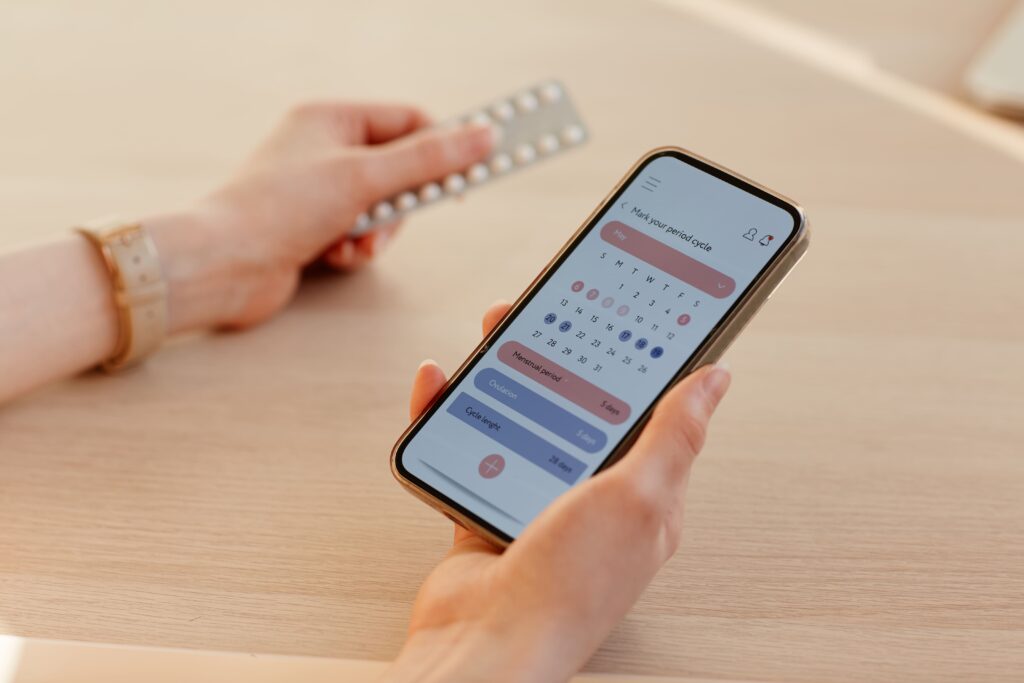El ciclo menstrual es un proceso propio del género femenino, que acompaña a las mujeres durante un largo periodo de su existencia. Es gracias a este proceso, que existe la posibilidad de crear nuevas vidas, al quedar embarazadas y cumplir los nueves meses de gestación.
Para comprender un poco más acerca de este ciclo, detallamos algunos conceptos básicos e información relevante al respecto.
¿Qué es el ciclo menstrual?
Lo que se conoce como ciclo menstrual consiste en un proceso hormonal, que tiene lugar en el organismo de las mujeres cada mes, con el objetivo de preparar al cuerpo para un posible embarazo.
Este ciclo abarca el tiempo que pasa entre una menstruación y otra, el cual dura en promedio 28 días. Aunque en algunos casos puede variar entre los 21 y los 35 días.
Cuando se presentan los períodos menstruales de manera regular, durante los años comprendidos entre la pubertad y la menopausia, es un síntoma de que tu cuerpo se encuentra funcionando de forma normal.
Los ciclos menstruales irregulares, que vienen acompañados de dolor y sangrado abundante, no son normales. Por otro lado, también existe el Síndrome Premenstrual (SPM), el cual es padecido por muchas mujeres, y que puede ser controlado con ciertas medidas.
El ciclo menstrual puede iniciarse en las mujeres en edades diferentes, usualmente ocurre entre los 8 y 16 años de edad.

Fases del ciclo menstrual
El periodo menstrual comprende cuatro fases que detallamos a continuación:
Menstruación
Esta consiste en el sangrado que se presenta mensualmente. Durante esta fase el organismo de las féminas procede a liberarse de las células que recubren el útero.
Desde el útero, el sangrado fluye por medio de una ventana localizada en el cuello uterino, y deja el cuerpo mediante la vagina. Usualmente se desecha una cantidad aproximada de sangre de 35 ml, pero el rango normal está entre 10 y 80 ml.
Los periodos menstruales comúnmente duran entre tres y cinco días, pero este tiempo puede variar entre una mujer y otra, al igual que la cantidad de sangrado. En términos generales, la menstruación puede durar entre dos y siete días.
Preovulación
Esta etapa ocurre posterior a la menstruación y antes de la ovulación. Durante esta fase el ovario genera una serie de hormonas denominadas estrógenos, encargadas de hacer que alguno de los óvulos que se encuentran dentro de él, madure.
En condiciones normales esta fase tiene lugar entre el sexto y decimotercero día del ciclo, pero esto puede cambiar incluso para la misma persona, a causa de factores como el estrés, el cambio de peso, ciertas patologías médicas, la dieta, etc.
Ovulación
En esta fase se completa la maduración del óvulo y este es trasladado hasta el útero por medio de una de las trompas de Falopio.
Durante esta etapa los niveles hormonales incrementan, y contribuyen con la preparación del recubrimiento del útero para un posible embarazo.
Teniendo todo esto en cuenta, se puede señalar que la mejor probabilidad para que se produzca un embarazo, se presenta durante los tres días previos a la ovulación o durante el día de la ovulación.
Postovulación
Cuando el óvulo no es fecundado, este involuciona y se expulsa en la siguiente menstruación. Posterior a la postovulación inicia un ciclo menstrual nuevo.
Cómo calcular mi ciclo menstrual
Para poder calcular tu ciclo menstrual adecuadamente, debes conocer la respuesta a ciertas interrogantes.
En primer lugar, debes saber cuántos días dura un ciclo menstrual, en promedio el periodo menstrual tiene una duración de 25 a 30 días, y en algunos casos puede variar entre 21 o más de 35 días. Además, considerando que cada organismo es diferente, es posible que el número de días de tu ciclo menstrual cambie de un mes a otro.
Con respecto a cuál es el primer día del ciclo menstrual, este es el primer día que se presenta tu sangrado. Lo estándar es que sangres entre dos y siete días.
Con estos números como base puedes saber cómo se cuenta el ciclo menstrual, lo cual es de gran utilidad para conocer la fecha de tu ovulación y lograr el embarazo que deseas. Al conocer la fecha de tu ovulación sabrás cuáles son tus días fértiles, e incrementarás tus probabilidades de lograr un embarazo.

Te indicamos los pasos para calcular tu ciclo menstrual y tus días fértiles:
- Toma nota de los días de duración promedio de tu periodo menstrual. Por ejemplo: de 28 a 30 días.
- Resta 18 al ciclo de menor duración: 28-18 = 10.
- A continuación resta 11 al ciclo de mayor duración: 30-11 = 19.
- Los resultados obtenidos: 10 y 19, indican los días de tu periodo fértil.
Cómo mejorar tu ciclo menstrual
Como ya lo mencionamos, son muchas las mujeres que padecen de irregularidades durante su periodo menstrual. Pero estas incomodidades se pueden controlar poniendo en práctica algunos hábitos naturales y saludables, como los siguientes:
Alimentación balanceada
Debes cuidar tu dieta y minimizar el consumo de alimentos como el gluten, los lácteos, las harinas y el azúcar, ya que estos pueden generar inflamación y dolor.
Lo más recomendable es que incluyas más verduras, frutas y proteínas. También puedes añadir suplementos como la vitamina D, el Zinc y el magnesio.
Evita las dietas restrictivas, ya que te estarás privando de nutrientes necesarios e importantes.
Aprende a gestionar el estrés
El estrés puede ser muy dañino para tu periodo menstrual, y es responsable de los ciclos anovulatorios, debido a que el cortisol destruye y acaba con las hormonas implicadas en el proceso.
Entre las alternativas que puedes implementar para gestionar el estrés, están la meditación y el ejercicio sin exceso.
Duerme y descansa lo necesario
Cuando disfrutas de un sueño completo y reparador también contribuyes a reducir el estrés en tu vida, ya que esto ayuda con la regulación de las hormonas que genera el estrés.
Por otro lado, dormir bien colabora con la secreción regular de la progesterona, el estrógeno y la hormona luteinizante; mientras duermes tu sistema inmune se fortalece, eliminas las toxinas, tu cuerpo se relaja y las células se reparan.
Hidrata tu cuerpo
Como complemento a una buena alimentación, también debes hidratarte ingiriendo agua en cantidades suficientes. Esto te ayuda a prevenir inflamaciones, migrañas, dolores y colabora con la desintoxicación de tu cuerpo.
Todos estos consejos son una respuesta efectiva a la interrogante de cómo sanar tu ciclo menstrual. Al ponerlas en práctica notarás la diferencia.



